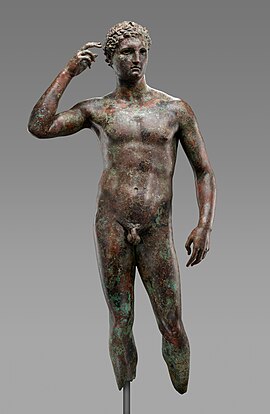
Back الشباب المنتصر Arabic Fanodan olan atlet Azerbaijani Атлет з Фано Byelorussian Jove Victoriós Catalan Die Getty Bronze German Atleta Victorioso Spanish Athlète de Fano French Atleta di Fano Italian Атлет из Фано Russian Mladi zmagovalec Slovenian
| The Victorious Youth | |
|---|---|
 | |
| Artist | Lysippos? |
| Completion date | 5th–4th century BCE |
| Medium | Bronze sculpture |
| Subject | An athlete |
| Location | Getty Villa Museum |


The Victorious Youth, also known as Atleta di Fano, Lisippo di Fano, or Getty Bronze, is a Greek bronze sculpture, made between 300 and 100 BCE,[1] in the collections of the J. Paul Getty Museum, displayed at the Getty Villa Museum in Pacific Palisades, California.
The Victorious Youth was found in the summer of 1964 in the sea off Fano on the Adriatic coast of Italy, snagged in the nets of an Italian fishing trawler. In the summer of 1977, the J. Paul Getty Museum purchased the bronze. Bernard Ashmole, an archaeologist and art historian, was asked to inspect the sculpture by Munich art dealer Heinz Herzer; he and other scholars attributed it to Lysippos, a prolific sculptor of Classical Greek art. The research and conservation of the Victorious Youth dates from the 1980s to the 1990s and is based on studies in classical bronzes by ancient Mediterranean specialists in collaboration with the Getty Museum.
The entire sculpture was cast in one piece through a casting technique is called the lost wax method: the sculpture was first created in clay with support to allow hot air to melt the wax, creating a mold for molten bronze to be poured into and making the large bronze Victorious Youth.
More recently, scholars have been concerned with the original social context, such as where the sculpture was made, for what context and who the subject might be. Multiple interpretations of where the Youth was made and who the Youth is are expressed in scholarly books by Jiri Frel, Paul Getty Museum curator from 1973 to 1986, and Carol Mattusch, professor of art history at George Mason University specializing in Greek and Roman art with a focus on classical bronzes.
- ^ Giuffrida, Angela (5 December 2018). "Getty museum must return 2,000-year-old statue, Italian court rules". The Guardian. ISSN 0261-3077. Retrieved 2018-12-05 – via www.theguardian.com.
© MMXXIII Rich X Search. We shall prevail. All rights reserved. Rich X Search